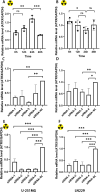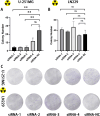Knockdown of ATRX enhances radiosensitivity in glioblastoma
- PMID: 38898533
- PMCID: PMC11186225
- DOI: 10.1186/s41016-024-00371-6
Knockdown of ATRX enhances radiosensitivity in glioblastoma
Abstract
Background: Glioblastoma are highly malignant type of primary brain tumors. Treatment for glioblastoma multiforme (GBM) generally involves surgery combined with chemotherapy and radiotherapy. However, the development of tumoral chemo- and radioresistance induces complexities in clinical practice. Multiple signaling pathways are known to be involved in radiation-induced cell survival. However, the role of alpha-thalassemia X-linked mutant retardation syndrome (ATRX), a chromatin remodeling protein, in GBM radioresistance remains unclear.
Methods: In the present study, the ATRX mutation rate in patients with glioma was obtained from The Cancer Genome Atlas, while its expression analyzed using bioinformatics. Datasets were also obtained from the Gene Expression Omnibus, and ATRX expression levels following irradiation of GBM were determined. The effects of ATRX on radiosensitivity were investigated using a knockdown assays.
Results: The present study demonstrated that the ATRX mutation rate in patients with GBM was significantly lower than that in patients with low-grade glioma, and that patients harboring an ATRX mutation exhibited a prolonged survival, compared with to those harboring the wild-type gene. Single-cell RNA sequencing demonstrated that ATRX counts increased 2 days after irradiation, with ATRX expression levels also increasing in U-251MG radioresistant cells. Moreover, the results of in vitro irradiation assays revealed that ATRX expression was increased in U-251MG cells, while ATRX knockdown was associated with increased levels of radiosensitivity.
Conclusions: High ATRX expression levels in primary GBM may contribute to high levels of radioresistance. Thus ATRX is a potential target for overcoming the radioresistance in GBM.
Keywords: ATRX; Glioblastoma; Knockdown; Radiosensitivity.
© 2024. The Author(s).
Conflict of interest statement
The authors declare that they have no competing interests.
Figures





Similar articles
-
ATRX-dependent SVCT2 mediates macrophage infiltration in the glioblastoma xenograft model.J Neurophysiol. 2022 May 1;127(5):1309-1316. doi: 10.1152/jn.00486.2021. Epub 2022 Apr 13. J Neurophysiol. 2022. PMID: 35417255
-
Gelsolin knockdown confers radiosensitivity to glioblastoma cells.Cancer Med. 2024 May;13(10):e7286. doi: 10.1002/cam4.7286. Cancer Med. 2024. PMID: 38803199 Free PMC article.
-
IDH1-R132H acts as a tumor suppressor in glioma via epigenetic up-regulation of the DNA damage response.Sci Transl Med. 2019 Feb 13;11(479):eaaq1427. doi: 10.1126/scitranslmed.aaq1427. Sci Transl Med. 2019. PMID: 30760578 Free PMC article.
-
Alpha Thalassemia/Mental Retardation Syndrome X-Linked, the Alternative Lengthening of Telomere Phenotype, and Gliomagenesis: Current Understandings and Future Potential.Front Oncol. 2018 Jan 8;7:322. doi: 10.3389/fonc.2017.00322. eCollection 2017. Front Oncol. 2018. PMID: 29359122 Free PMC article. Review.
-
Targeting Telomerase and ATRX/DAXX Inducing Tumor Senescence and Apoptosis in the Malignant Glioma.Int J Mol Sci. 2019 Jan 8;20(1):200. doi: 10.3390/ijms20010200. Int J Mol Sci. 2019. PMID: 30625996 Free PMC article. Review.
Cited by
-
Variability in radiotherapy outcomes across cancer types: a comparative study of glioblastoma multiforme and low-grade gliomas.Aging (Albany NY). 2025 Feb 27;17(2):550-562. doi: 10.18632/aging.206212. Epub 2025 Feb 27. Aging (Albany NY). 2025. PMID: 40015963 Free PMC article.
-
Advances in Glioblastoma Diagnosis: Integrating Genetics, Noninvasive Sampling, and Advanced Imaging.Cancers (Basel). 2025 Jan 2;17(1):124. doi: 10.3390/cancers17010124. Cancers (Basel). 2025. PMID: 39796751 Free PMC article. Review.
References
LinkOut - more resources
Full Text Sources
